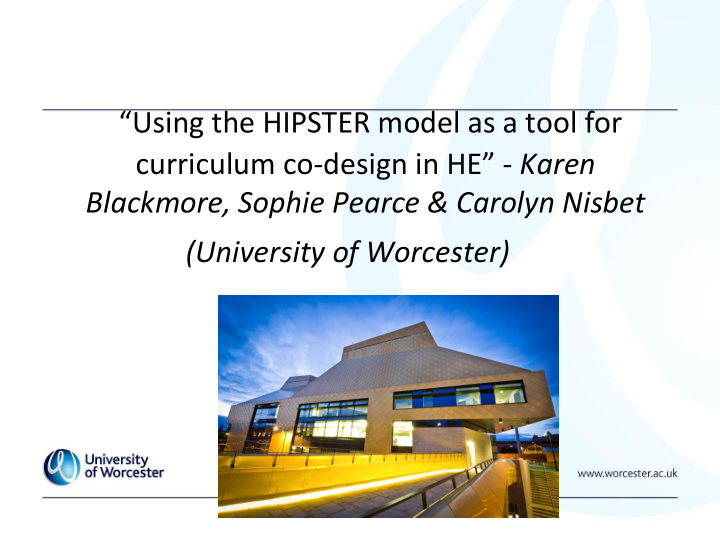



“Using the HIPSTER model as a tool for curriculum co- design in HE” - Karen Blackmore, Sophie Pearce & Carolyn Nisbet (University of Worcester)
Workshop structure • Outline of the Students and Academic Partners Scheme (SAPs) at UW. • Description of HIPSTER model. • Illustration of learning experience by student partner. • Critique of model by participants. • Sharing of experiences of participants in terms of evaluating High Impact Learning Processes. • Plenary – forward thinking.
SAP history at the University of Worcester • The SAP scheme is now in its 6th year with over 100 projects supported since 2011 • Outputs cover all aspects of teaching and learning • Developing dissemination strategy: – Contributions to annual Learning, Teaching and Student Experience conference – Reports selected for Worcester Journal of Learning and Teaching – Project presentations at external conferences
Scheme aims
Use of the HIPSTER model • It is envisaged that the model could be used in several ways: • Making explicit the characteristics of very effective learning for the students involved in the projects. • Identifying attributes of highly successful projects in terms of their likely impact. • Highlight excellent andragogy within Institutions.
Moving forward Once the model is established and refined it might be used by applicants to the scheme for identifying teaching practice that is potentially excellent and perhaps aid the formulation of projects. In order for the model to be proved as viable, it is intended that data will be accrued year-on – year from specifically facilitate high impact learning within the scheme.
HIPSTER (High Impact Pedagogies Supporting Teaching Excellence Reflexion) model Explicit modelling of effective communication including subject specific terminology. Facilitation of Accessible bespoke subject matter andragogic knowledge and processes that expertise. facilitate metacognition. Teaching Excellence Systematic and Student centred responsive mentoring and assessment and coaching. feedback
HIPSTER (High Impact Pedagogies Supporting Teaching Excellence Reflexion) model Explicit modelling of effective communication including subject specific terminology. Facilitation of Accessible bespoke subject matter andragogic knowledge and processes that expertise. facilitate metacognition. Teaching Excellence Systematic and Student centred responsive mentoring and assessment and coaching. feedback Vertical peer mentoring
Work based learning • Linking research and study to real-world WBL environments provides additional benefits for students Work based professional • Projects developing practices involving WBL include: learning. • Developing a behaviour toolkit for use in class and partner schools for Primary Teacher Training • Embedding support for employability in Psychology modules to enhance the development of knowledge, skills and experience • Planning and facilitate a values-based pupil conference for year five pupils from a cross partnership school group • Analysis of whether social worker students feel that they could benefit from counselling during training to increase their resilience and thus improve retention • Using student nurses as teachers of basic life support to school children
Technology Enhanced Learning On-line • Giving students opportunity to develop autonomy, student led journal fulfils an adult learning need. • A highlight of the scheme last academic year, was the successful completion of a project involving students from the Institute of Creative Arts (ICA) creating an on-line student journal showcasing post-modern creative writing pieces. This project afforded the students opportunities to demonstrate mastery of current advanced communication techniques. They subsequently gained further funding to develop the project.
Online learning Developing innovative tools and enhancements for on-line learning: • Online Centre for Achievement and Progression • Worcester University Student Technology Application (WUSTA) Competition • Mapping the Student Digital Experience • An innovative digital teaching and learning platform for partnership between tertiary and secondary education • Maximizing the use of the VLE to improve the student experience
Peer Mentoring • Peer mentoring within undergraduate teaching can provide highly responsive feedback elements and is an important formative tool. • One excellent example of a high impact learning activity was exemplified by the project led within the ICA where vertical peer tutoring was used as a means of supporting learning through screen writing modules. • It was very clear from student feedback , that this highly innovative andragogic approach was valued as a means of supporting deep learning and effective communication by students learning on these modules.
Sophie Pearce student experience • https://uniworcac- my.sharepoint.com/personal/peag1_14_uni_wor c_ac_uk/_layouts/15/guestaccess.aspx?docid=12 ba9d1bad1394cedbdef502a3e35c35b&authkey= Ad4TfaNB1wtLh6yTMITw8eQ&expiration=2017- 07-11T09%3a35%3a52.000Z
Sharing experiences • We would like to hear your feedback on the HIPSTER model which we are developing. Please feel free to discuss and annotate coloured copies of the model. • Ideas • Usefulness? • Modifications?
Plenary sharing your experiences • How does your institution evaluate deep learning from student/ staff collaborations? • How can such schemes be moved strategically forward? • We are looking for collaborative opportunities with other HEIs. k.blackmore@worc.ac.uk
Bibliography • Alt (2014) The construction and validation of a new scale for measuring features of constructivist learning environments in higher education http://journals.sfu.ca/flr/index.php/journal/article/view/68 • Baxter Magolda (1992) Students' epistemologies and academic experiences: implications for pedagogy, Review of Higher Education 15 (3), 265-87. • Burns (1995) The adult learner at work. Business and Professional Publishing, Sydney. • Evans (2016) High impact pedagogies and student engagement in learning https://www.google.co.uk/#q=carol+evans+high+impact+practices&spf=73 • Healy and Jenkins (2009) https://www.heacademy.ac.uk/system/files/developingundergraduate_final.pdf • Kuh, G. (2008) High-Impact Educational Practices: What They Are, Who Has Access to Them, and Why They Matter . https://www.aacu.org/leap/hips • Schreyer Institute for Teaching Excellence (2016) The definition of teaching excellence. Penn State University http://www.schreyerinstitute.psu.edu/Definition/
Recommend
More recommend